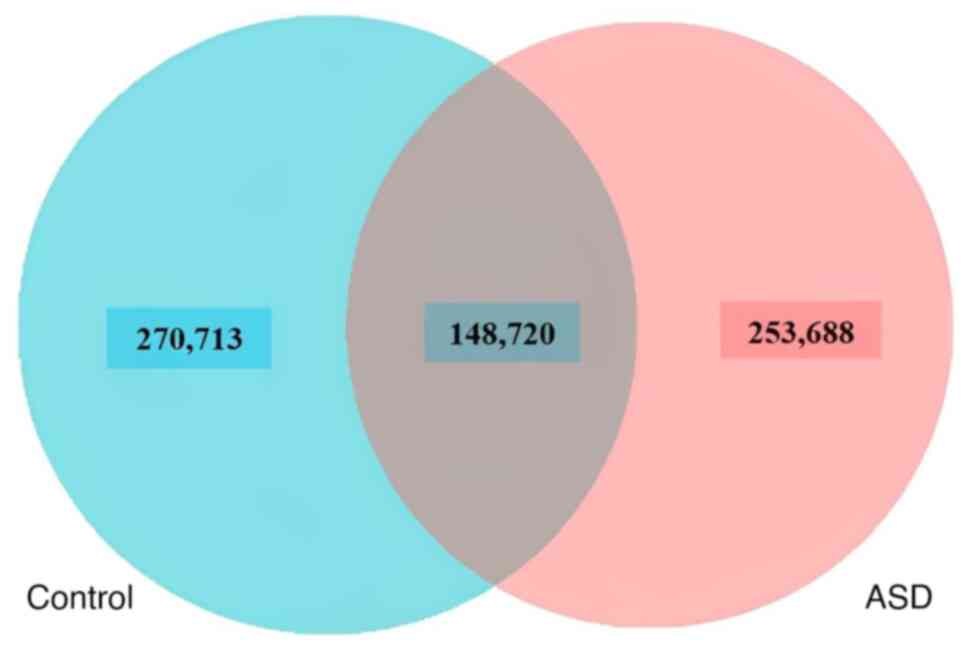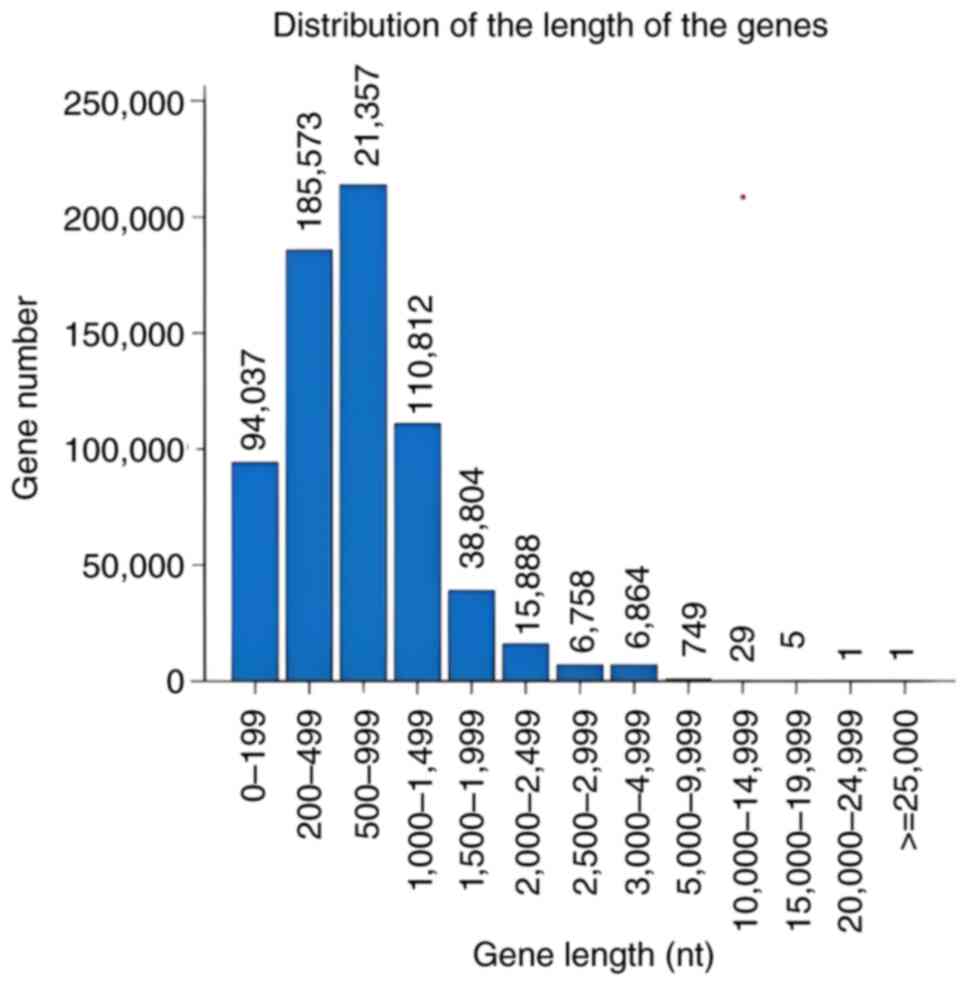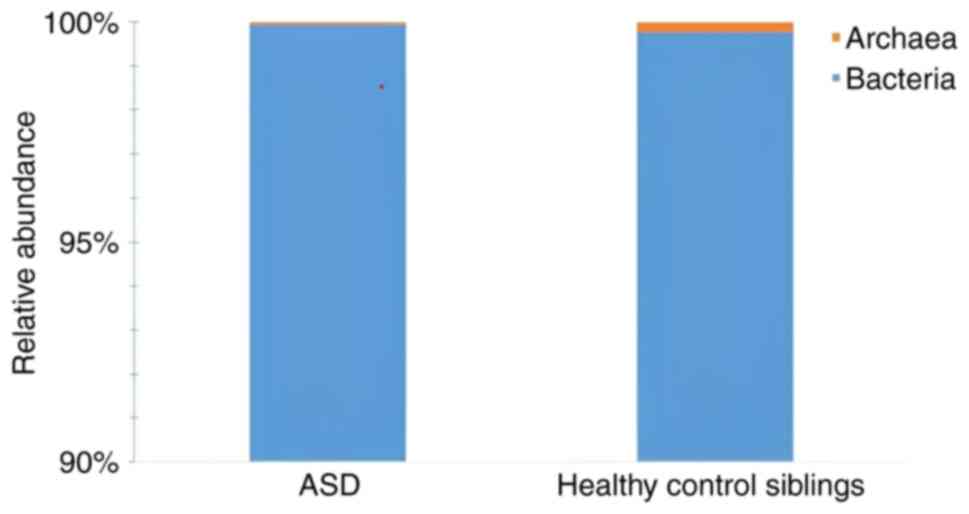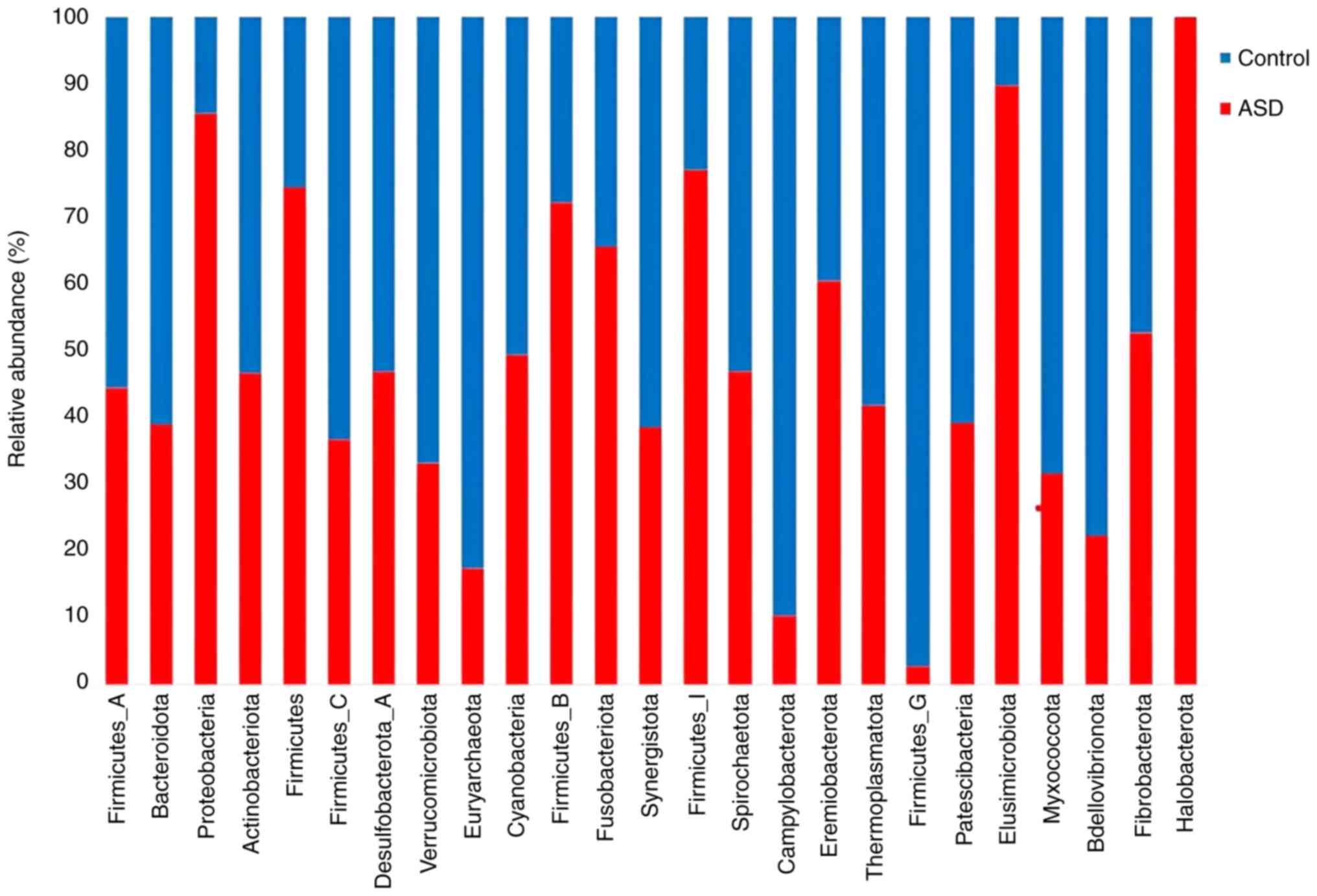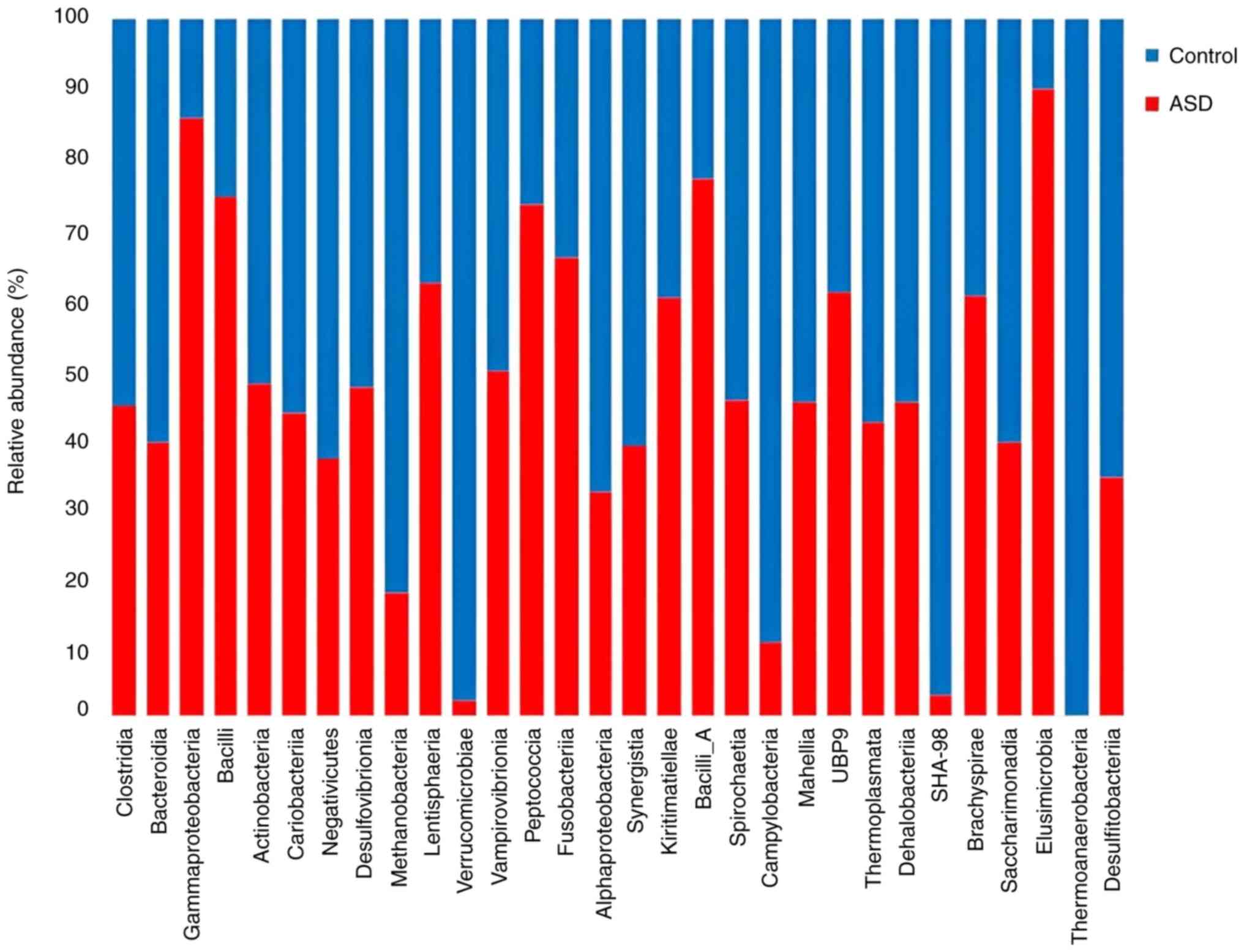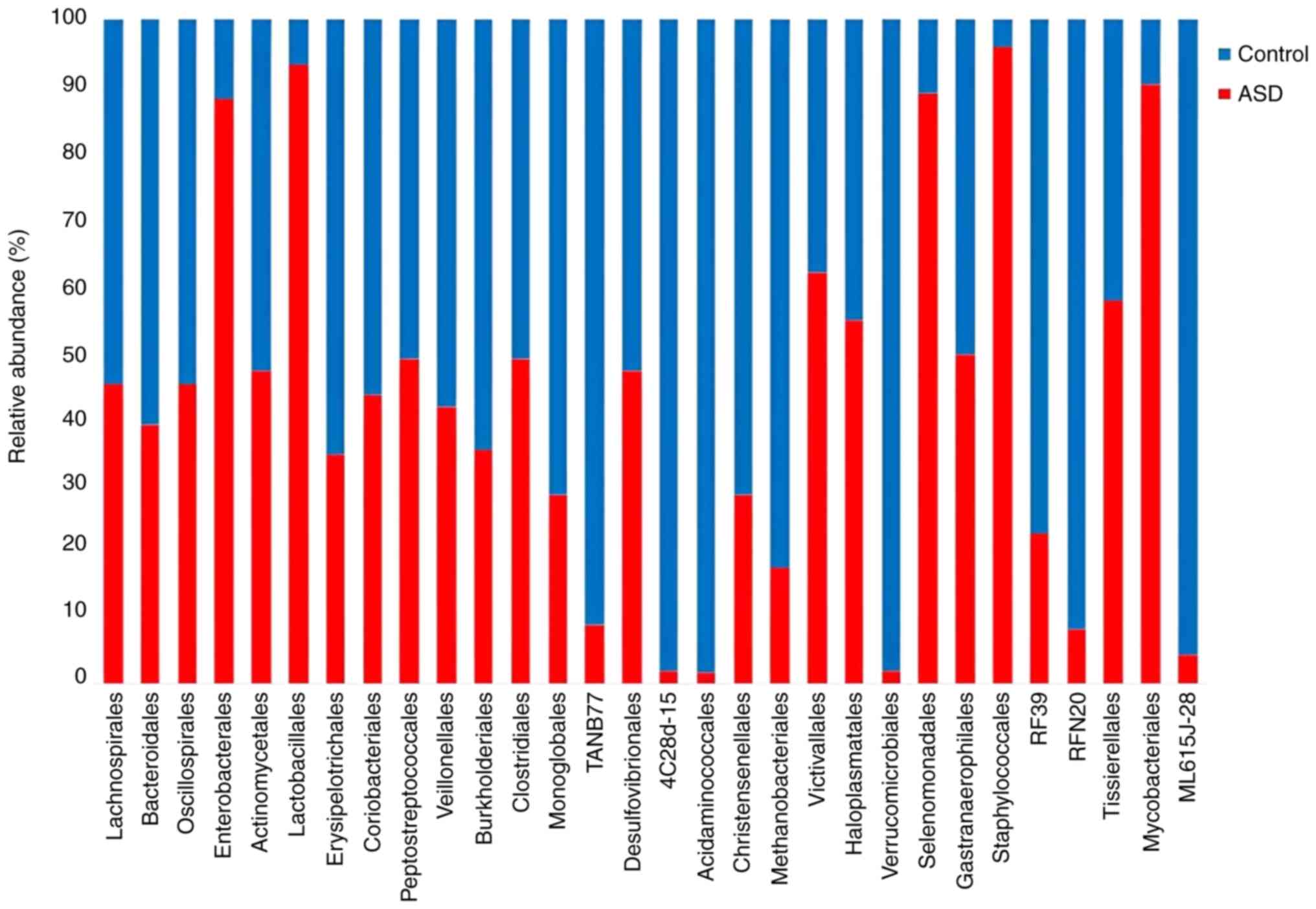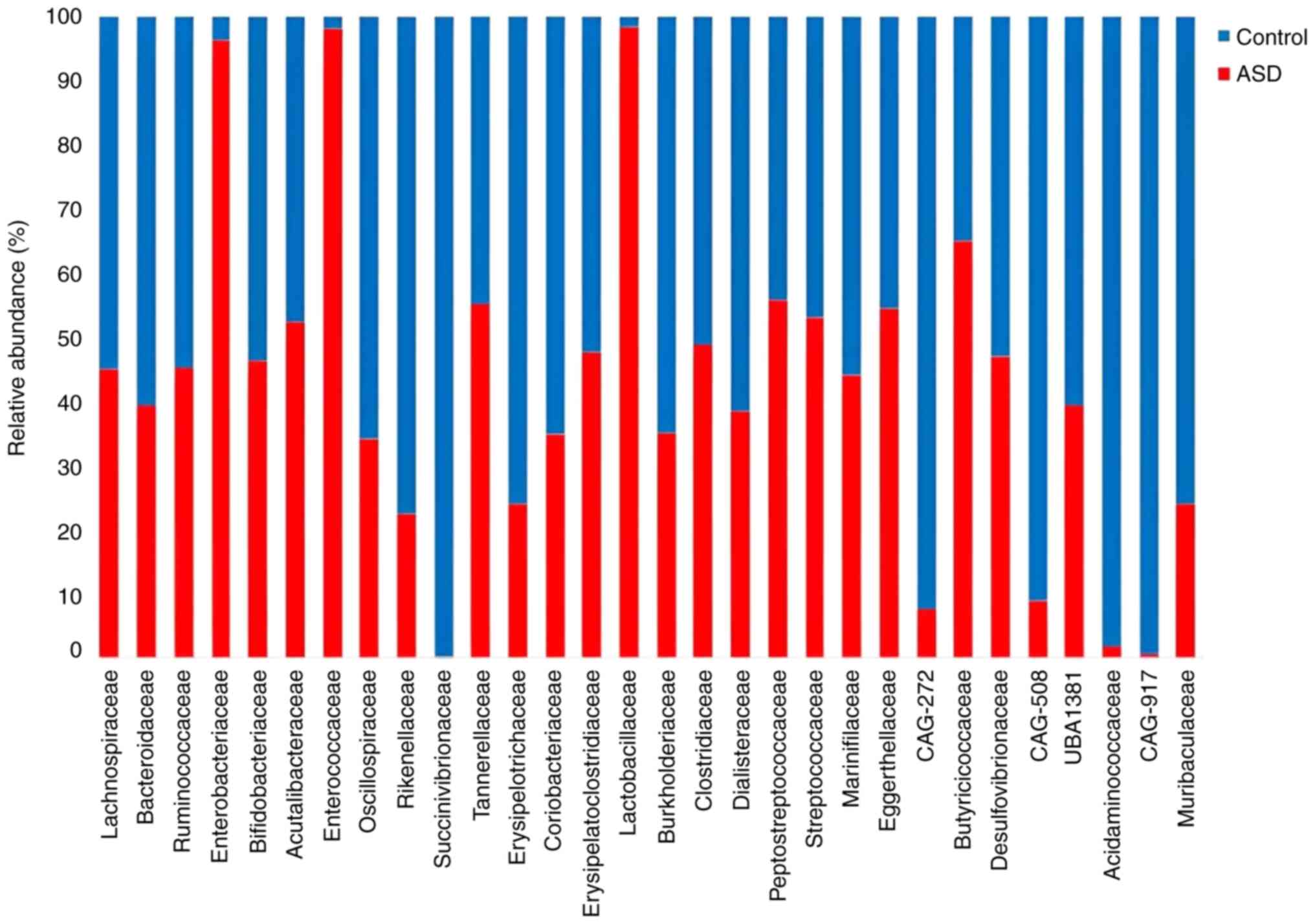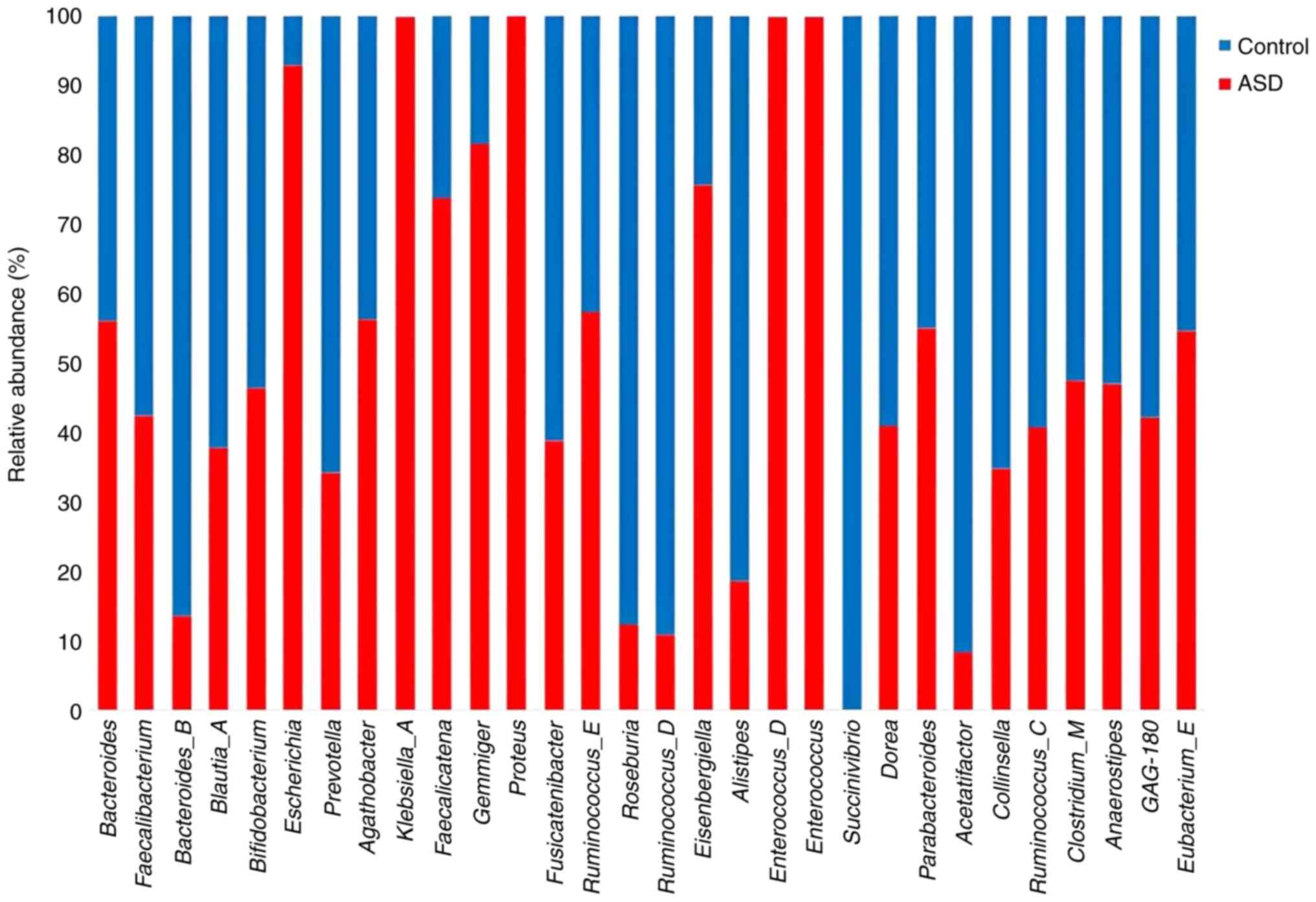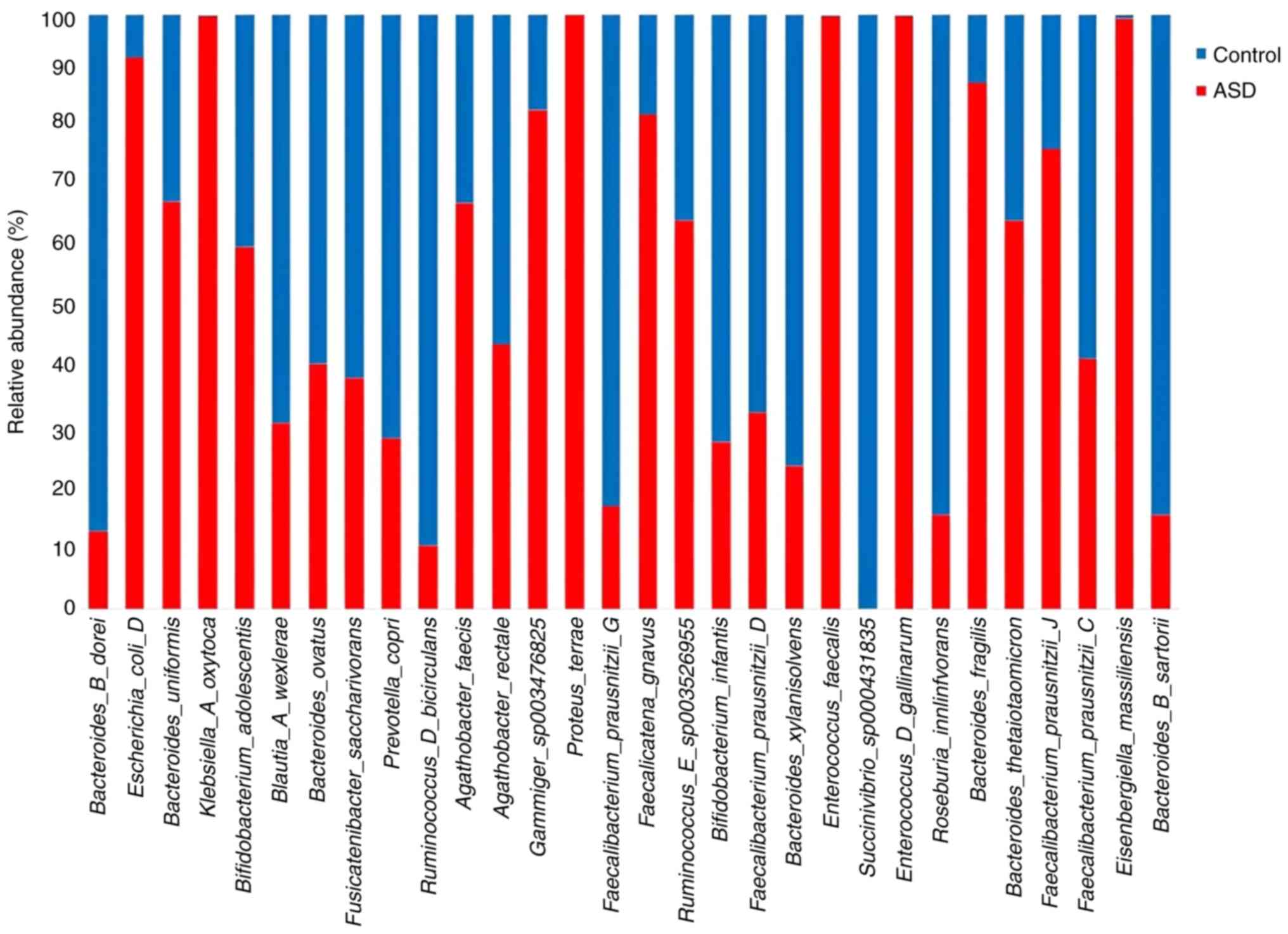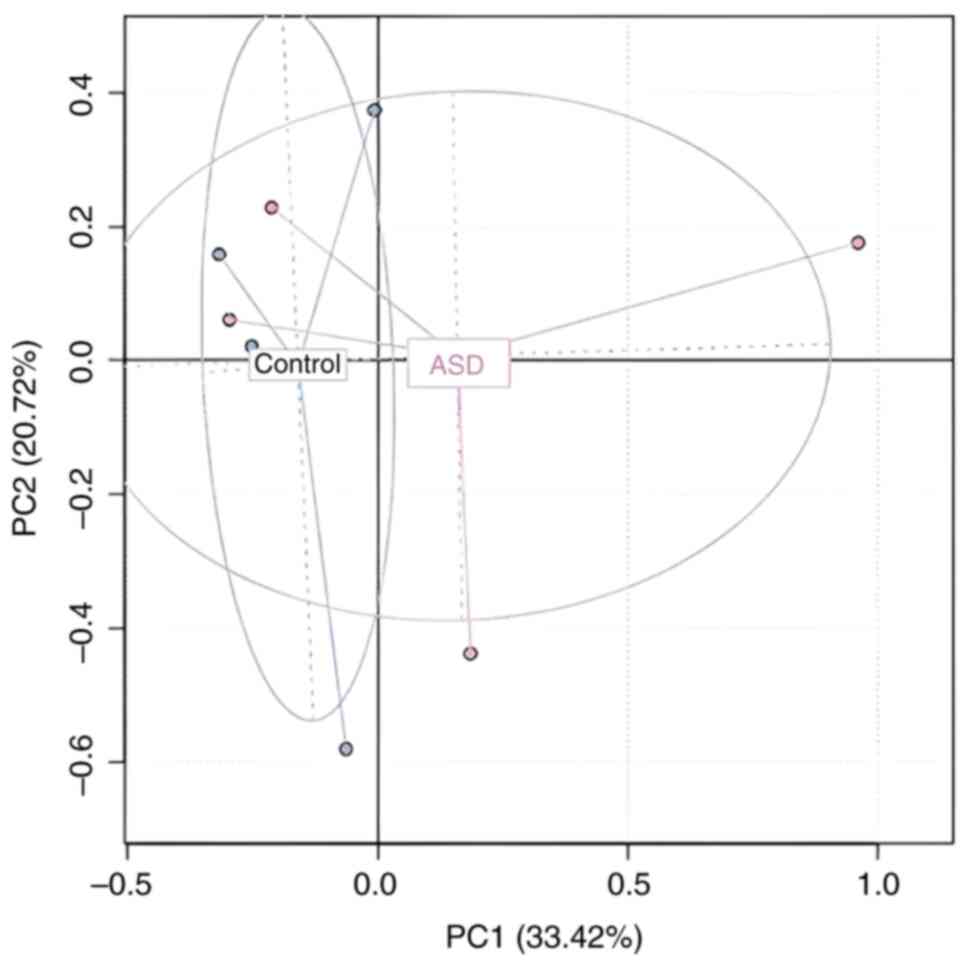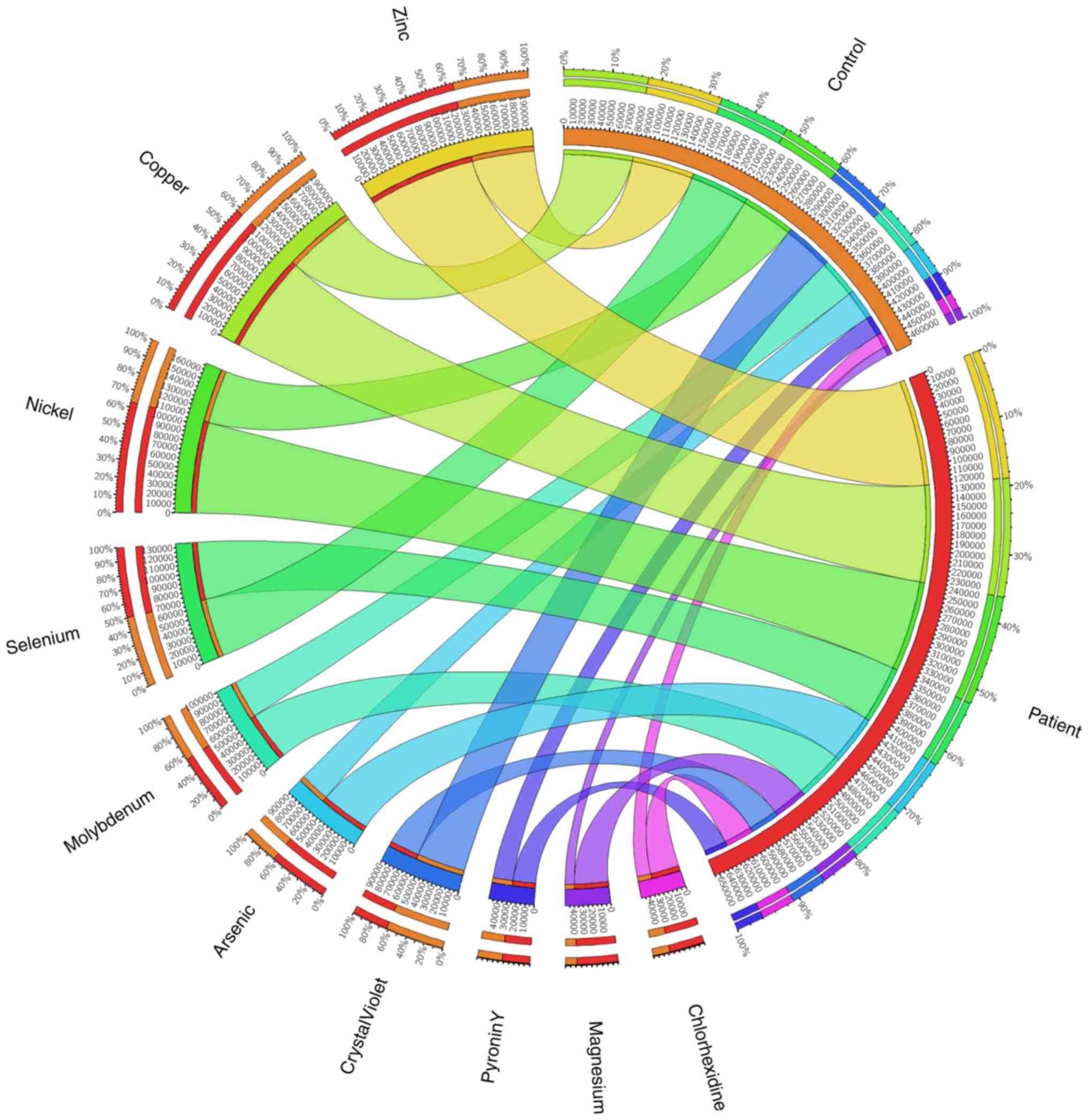Gut microbiota of children with autism spectrum disorder and healthy siblings: A comparative study
- Authors:
- Published online on: September 16, 2024 https://doi.org/10.3892/etm.2024.12719
- Article Number: 430
-
Copyright: © Abuljadayel et al. This is an open access article distributed under the terms of Creative Commons Attribution License.
Abstract
Introduction
The quality of life for an individual is negatively affected by autism spectrum disorder (ASD), a neurodevelopmental condition that affects social communications and results in obstinate and repetitive behaviors (1). Gastrointestinal (GI) tract issues, such as food intolerance, abdominal pain, inflammatory disease, digestive disorders, diarrhea, or constipation are common in autistic patients in addition to the characteristic cognitive traits (2). Although ASD can be identified in children as young as 3 years old, symptoms persist throughout an the life of an individual (3). The human gut microbiome (GM) is home to a complex ecosystem of microorganisms living in the GI tract including viruses, eukaryotes, archaea and bacteria (4). Additionally, saprophytic commensal flora in the gut plays a crucial role in modulating a variety of local functions, including nutrient absorption, maintenance of the intestinal barrier, stimulation and regulation of the host immune system and defense against pathogenic microorganisms (4-7). An imbalance in the gut microbiota is referred to as dysbiosis and can interfere with a wide range of biological mechanisms. Alterations in systemic metabolism, neuroplasticity and the neuroimmune system, all of which have been linked to ASD (8-13), may result from dysbiosis. Additionally, the GM interacts with relevant host, microbiota and environmental factors that can result in gut dysbiosis (14,15). Numerous studies have shown that gastrointestinal dysfunction coexists with ASD (16-21). According to literature reviews of the human gut microbiota, the coordination between the brain and the microflora of the gastrointestinal tract can be disrupted by changes in the composition of the GM (22). The ability to identify microorganisms from all domains of life is the primary advantage of metagenomic whole genome shotgun sequencing (mWGS) for taxonomic classification over amplicon sequencing or marker gene approaches (23). Given the complex enteric nervous system in the gut directly interferes with the brain and permits the bidirectional flow of information, microbiome research that focuses on the relationship between ASD and gut microbiota is crucial. This enhances functions and emotions that may be affected by gastrointestinal contents, such as cognition and function (22). Therefore, changes in the composition of the microbiome may result in disturbed host-microbiota homeostasis and cause autism (24). Changes in the GM composition have been observed in individuals with ASD (25). The immune pathway is largely involved in regulating microbial profiles, supporting the theory of a complex relationship between ASD, immune dysregulation, and altered microbiome that may aid in the identification of molecular biomarkers for the diagnosis of ASD (26). According to a recent study, the gut-brain and gut metabolic models of ASD with GI symptoms showed abnormalities in several cases, including neurotoxin-related p-cresol degradation and short-chain fatty acid (SCFA) degradation/synthesis, which are closely associated with ASD behaviors in animal models (27). Additionally, the GM is the primary contributing factor for behavioral symptoms and gastrointestinal symptoms linked to ASD (28). Through pathways connected to the gut-brain axis, the gut microbiota and their metabolic products, such as SCFAs, may have an effect on the metabolism of central neurotransmitters (29). Furthermore, a variety of factors, such as antibiotics, pH, oxygen levels, dietary supplements including probiotics and prebiotics, and bacterial load, can alter the composition of the gut microbiota (30). Probiotic administration to regulate the gut-brain axis may improve gastrointestinal symptoms, reduce inflammation and restore behavioral symptoms associated with ASD, as well as the gut microbiota composition and intestinal barrier function in animal and human models (31). The gut-brain axis is altered by gut dysbiosis, which increases the risk of developing ASD and other disorders (32). It has been established that the gut-brain axis links various brain functions, including the emotional and cognitive functions of the limbic system, prefrontal cortex, and hypothalamus (33). The central nervous system, the hypothalamic-pituitary-adrenal axis, the enteric nervous system and the autonomic nervous system all have bidirectional, intricately integrated signaling pathways that together make up the gut-brain axis (34). Through vagal stimulation and inflammatory mediators and their metabolites, the GM can directly affect these processes (35). Regarding somatic complaints and symptoms, self-dysregulation, criminal behavior, and cognitive difficulties are markedly associated with changes in taxonomic diversity in individuals with ASD (26).
To classify and identify molecular biomarkers for ASD, the present study aimed to evaluate the differences in the composition of the gut microbiota between children with autism and their healthy siblings.
Materials and methods
Sampling
Fecal samples were taken at Pediatric Clinics in King Abdulaziz University Hospital in Jeddah, Saudi Arabia, over 1 month in March 2022. A total of eight children, aged 3-10 years old, including four patients with ASD (three males and one female) and four of their siblings who were healthy controls (two females and two males), were recruited; the characteristics of the children with ASD are presented in Tables I and II. The Biomedical Ethics Research Committee at King Abdulaziz University (Jeddah, Kingdom of Saudi Arabia) approved the present study (approval no. 10-CEGMR-Bioeth-2021). To guarantee the integrity of the DNA for deep sequencing and microbiome analysis, all samples were collected using particular collection tubes (ISWAB microbiome collection tube).
Extraction of genomic DNA
Following the manufacturer's instructions, DNA was extracted from fecal samples using a QIAMP mini kit designed for stool purification (QIAamp DNA Mini Kit; Qiagen GmbH). A DeNovix DS-11 FX Spectrophotometer/Fluorometer nanodrop (Thermo Fisher Scientific, Inc.) was used to assess the integrity and purity of the sample.
Bioinformatics analysis
The Beijing Genomics Institute sent eight samples of genomic DNA (four from the patients with ASD and four from the healthy individuals) for bioinformatics analysis. The DNBSEQ platform was used to test the samples initially. The total number of detected gene catalogs was 673,091, which were functionally annotated by seven databases, including BacMet (Antibacterial Biocide and Metal Resistance Genes Database; version 20180311; http://bacmet.biomedicine.gu.se/), CARD (The Comprehensive Antibiotic Resistance Database; version 3.0.9; https://card.mcmaster.ca/), KEGG (Kyoto Encyclopedia of Genes and Genomes; version 101; http://www.genome.ad.jp/kegg/), eggNOG (evolutionary genealogy of genes: Non-supervised Orthologous Groups; version 5.0; http://eggnog6.embl.de/), COG (Clusters of Orthologous Groups; version 20201125; https://www.ncbi.nlm.nih.gov/research/cog-project/), (Swiss-Prot; release-2021_04; https://www.uniprot.org/), and CAZy (Carbohydrate-Active enZYmes Database; version 20211013; http://www.cazy.org/). The average output of each sample was 6.04 gigabyte of data and the average assembly length was 134.31 megabytes. Following taxonomy analysis, the number of species found was as follows: Kingdom level, 2; phylum level, 25; class level, 34; order level, 84; family level, 257; genus level, 1,314; and species level, 4,339.
The library was sequenced on a DNBSEQ-400RS using a DNA Library Prep Kit (cat. no. 1000017571, MGI Tech Co., Ltd.). The main steps of sequencing and library preparation were as follows: The concentration of the sample was detected using a Qubit Fluorometer (Invitrogen; Thermo Fisher Scientific, Inc.), and the integrity and purity of samples were assessed by agarose gel electrophoresis (concentration of agarose gel, 1%; 150 V; electrophoresis time, 40 min). A total of 1 µg genomic DNA was randomly fragmented using an ultrasonicator (M220; Covaris, Inc.). 75.0 W (Peak incident power), 5.0% duty factor, 200 cycles per burst, 50 sec treatment time), 20.0˚C temperature, 50 µl sample volume, and 200-400 bp fragments of genomic DNA were selected by 2.8 µm of Dynabeads M-280 Streptavidin magnetic beads (cat. no. 112-05D; Invitrogen; Thermo Fisher Scientific, Inc.). Next, the fragments were end-repaired and then 3' adenylated, then adaptors were ligated to the ends of these 3' adenylated fragments. PCR was used [98˚C/1 min, 11 cycles of (98˚C/10 sec, 60˚C/30 sec, 72˚C/30 sec), 72˚C/5 min and 4˚C/hold] to amplify fragments with adaptors from the previous step, and then PCR products were purified using the magnetic beads. The double-stranded PCR products were heat-denatured and circularized by the splint oligo sequence. The single-strand circle DNA was formatted as the final library. The library was amplified using phi29 to make a DNA nanoball (DNB) which contained >300 copies of one molecule. The DNBs were loaded into the patterned nanoarray, and pair-end 100/150 base reads were generated by combinatorial probe-anchor synthesis.
Since a certain percentage of low-quality linker sequences may have been present in the original sequencing data, SOAPnuke software (version 1.5.0; https://github.com/BGI-flexlab/SOAPnuke) was used to filter out the low-quality data to obtain high-quality clean data. MEGAHIT (version 1.1.3; https://github.com/voutcn/megahit) was used to put together clean, filtered data, and to remove sequences <300 bp, as well as for statistical analysis and gene prediction. MetaGeneMark (version 3.38; http://exon.gatech.edu/index.html) was used to perform metagenomic gene prediction for the assembled scaffold, CD-HIT (version 4.6.4; http://weizhong-lab.ucsd.edu/cd-hit/) was used to cluster predicted genes, and redundant sequences were removed to create the gene catalog. Then, Venn diagrams were created between various samples or groups by aligning reads with non-redundant gene catalogs using Salmon (version 1.3.0; https://github.com/COMBINE-lab/salmon). Kraken (version 2.1.2; https://github.com/DerrickWood/kraken2) was used to perform the taxonomy annotation for the metagenomic data, to determine the species abundance and to compare or contrast various samples or groups. Bar charts, nonmetric multidimensional scaling dimension reduction analysis, principal component analysis (PCA), principal coordinates analysis (PCoA), anosim analysis of similarity of different species and multivariate statistical analysis of linear discriminant analysis were all employed in the metagenomic taxonomy analysis. The analysis of species diversity in a single sample is called α diversity. The functional database was screened for the absolute abundance profile, the top 10 abundant genes were assigned functional Circos (https://circos.ca), and the distribution of the corresponding functional genes in each group was visually displayed.
Results
To identify the taxonomic classification of the GM and demonstrate the differences in gut microbe abundance between children with ASD and their healthy control siblings, mWGS was conducted on the GMs of both children with ASD and their healthy control siblings. Tables III and IV show the statistics of the raw metagenomics data (filtering and assembly). Using a Venn diagram, it can be seen that there were 253,688 unique genes found in children with autism, compared with 270,713 unique genes in healthy control subjects. The overlap area, or core genes, between the samples of ASD and healthy control subjects was 148,720, indicating that there were also shared genes between the two groups of children (Fig. 1). To determine the functional regions of genes and the distribution of gene length for gene prediction, the assembled genomic sequences based on gene structure information was used. The longer gene query was 213,570 base pairs, while the shorter gene query was 1 (Fig. 2).
Table IIIFiltering statistics for the DNA samples collected from fecal samples of four children with autism (A) and four healthy control siblings (C). |
Table IVAssembly statistics for the DNA samples collected from fecal samples of four children with autism (A) and four healthy control siblings (C) by using megahit software. |
The findings showed that all samples had the highest evenness (high community biodiversity) and richness at the kingdom level. Autistic samples with high evenness displayed higher levels of richness (Fig. 3). Compared with their siblings, the microbiomes of children with autism had undergone more changes. In addition, when compared with the ASD samples, the healthy control sibling samples had a higher level of Archaea and a lower level of Bacteria at the kingdom level (Fig. 3). At the phylum level, all samples had a propensity for high richness and low evenness between the two groups. The species richness was higher in all samples from healthy control siblings. The phyla proteobacteria and Firmicutes were the most abundant in the ASD samples. Several phyla, including Bdellovibrionota, Verrucomicrobiota, and Bacteroidota, showed a higher abundance in the healthy control sibling samples (Fig. 4).
Additionally, there were differences in the diversity of the healthy control and ASD samples at the class level. When compared with healthy controls, ASD samples had higher richness and lower evenness, which shows that children with autism had more pronounced changes in their microbiome diversity. Furthermore, only children in good health contained members of the Thermoanaerobacteria class. Methanobacteria and Verrucomicrobiae were more abundant in the healthy control samples than they were in the ASD samples. ASD samples had a noticeably higher concentration of Gammaproteobacteria, Bacilli, and Elusimicrobia (Fig. 5). In comparison with the normal controls, all ASD samples displayed a higher abundance and evenness at the order level. The Enterobacterales, Staphylococcales, Halomicrobiota, and Mycobacteriales were the orders with the highest abundance in the ASD samples. Verrucomicrobiales, Acidaminococcales, and 4C28d-15 exhibited the highest abundance orders in the healthy controls (Fig. 6). Moreover, ASD children had a higher abundance of Enterobacterales and Lactobacillales at order level. However, Lachnospirales was found in fluctuated abundance in both ASD and controls. Results at the family level revealed that children with ASD had a discernible change in diversity. Furthermore, as shown in Fig. 7, the Lactobacillaceae, Enterobacteriaceae, and Peptostreptococcaceae families were more abundant in the children with ASD than they were in the healthy controls, whereas the Succinivibrionaceae and Acidaminococcaceae families were more abundant in the controls. These findings showed that ASD samples and their healthy control siblings had higher richness and lower evenness across all samples at both the genus and species levels. Bacteroidetes_B, Bifidobacterium, Prevotella, and Blautia were more abundant in the healthy control samples compared with the ASD samples while Parabacteroides and Proteus were more abundant in the ASD samples (Fig. 8). Bacteroides uniformis, Bacteroides fragilis, Klebsiella A oxytoca, and Faecalibacterium prausnitziia J were more abundant in the children with ASD at species level, whereas Roseburia inulinivorans and Bifidobacterium infantis were higher in the healthy control samples (Fig. 9).
Principal coordinate analysis (PCoA) plot with Bray-Curtis dissimilarity both depicted β diversity (36). The difference in species diversity between two or more communities is referred to as β diversity. To describe β-diversity patterns, PCA based on Bray Curtis distances was used. This divides samples based on a single condition, whether it is an ASD or a healthy condition. The results show that among ASD, the biggest data changes were seen at the species level, whereas relatively small changes were seen among samples of healthy controls. It is notable that the PCA1 axis was able to completely distinguish between healthy controls and ASD Although some pathological samples were present with the control, the general separation between samples from the children with ASD and healthy controls across one condition is shown in Fig. 10, despite the overlap between the ASD and healthy control samples being separated. The findings also revealed the presence of a few minerals and dyes, which are listed in Fig. 11 in order of decreasing abundance. The findings indicated that compared with their healthy control siblings, children with ASD exhibited higher levels of zinc (Zn), copper (Cu), and nickel (Ni), suggesting that these elements may have some association with autism.
The results of the association between mineral concentrations and gene abundance that affects the way these minerals work is shown in Fig. 11. Of note, 124,053.237 genes or 60% of the Zn genes were found in the ASD samples, compared with 72,194.72 genes or 40% of the Zn genes in the control samples. For Cu, the numbers were ~113,018.838 genes (55%) and 81,013.569 genes (50%), respectively, in the control and ASD samples. For Ni, the numbers were ~105,305.895 genes in ASD samples (60%) compared with 61,909.547 genes in controls (45%). For selenium, the numbers were 66,569.415 genes and 67,635.147 genes, and for pyronin Y they were 26,602.361 and 23,183.965, in the ASD and control samples respectively, suggesting approximately equal amounts (~50%). According to the findings, the amount of molybdenum increased in the ASD group by 55%, arsenic by 60%, magnesium by 80% and chlorhexidine by 90%. When compared with the control sample, the abundance of crystal violet was 60% while in the ASD samples it was 30%.
Discussion
The present study aimed to classify and identify molecular biomarkers for ASD by examining differences in the composition of the gut microbiota between children with autism and their healthy siblings. Children with ASD have a different GM compared with healthy controls, according to the results of the present study, which showed higher levels of bacteria in children with autism compared with the healthy controls. The GMs of children with ASD were more diverse, rich and biomass-rich than those of typically developing children, which is consistent with earlier research by Finegold et al (37) and De Angelis et al (38).
The findings at the phylum level showed that children with ASD had a higher abundance of the phylum Proteobacteria, which is associated with host inflammation (39). Animal studies found that Proteobacteria produce lipopolysaccharides (LPS), which result in a decreased level of glutathione in the brain and this is a primary cause of immune dysregulation in individuals with ASD (40,41). Additionally, there was a higher abundance of Firmicutes in the samples from the patients with autism, which is consistent with a prior study by Tomova et al (42). Bdellovibrionota and Verrucomicrobia phyla were more abundant in healthy control samples. Bdellovibrionota is an obligate predator that can engulf and kill other gram-negative bacteria (43). It may thus serve as a protective agent against pathogens, resulting in a decrease in the number of harmful bacteria in the gut of healthy control siblings (44). Additionally, the most abundant phyla in healthy control samples were Verrucomicrobiota, which is consistent with a previous study by Zou et al (45). Members of the Verrucomicrobiota phylum are mucin-degrading bacteria that contribute to glucose homeostasis and intestinal health (46). Furthermore, the results of the present study showed that the Bacteroidota phylum was more abundant in healthy individuals than in patients with ASD, which is consistent with the findings of Settanni et al (47). Bacteroidota is responsible for the digestion of polysaccharides, thus a reduction in this phylum results in mucosal dysbiosis in the gut and abnormal digestion of carbohydrates in children with autism (48,49).
Results at the class level showed that Thermoanaerobacteria were only present in the healthy control groups. Thermoanaerobacteria play a role in the fermentation of both carbohydrates and polysaccharides by producing L-lactic acid, H2, CO2, acetic acid and ethanol (50-52). Methanobacteria were more abundant in healthy control siblings and they produce methane as a metabolic by-product (53). A reduction in the number of microorganisms producing methane is a major mechanism of hydrogen disposal in the human colon, which can be associated with excess abdominal gas in irritable bowel syndrome (54). Additionally, there were more Verrucomicrobiae in healthy controls than in the ASD samples. As aforementioned, the Verrucomicrobiae class is a mucin-degrading bacteria residing in the intestinal mucosa, which plays a role in glucose homeostasis and intestinal health and serves as an interface between host tissues and the human GM (55). Children with ASD had higher levels of Gammaproteobacteria and Bacilli, which is consistent with the study by Plaza-Díaz et al (56). Gammaproteobacteria contains most of the human pathogens; for example, Salmonella and Escherichia coli, some of these genera exist in symbiosis with hydrothermal vent-dwelling animals while others are methane oxidizers (57). Bacilli are known to cause diarrhea, nausea, vomiting and abdominal pain (58), which may be associated with GI symptoms in children with ASD.
At the order level, Enterobacterales were more abundant in ASD samples. This order includes several harmful gram-negative bacteria that are responsible for numerous enteric infections including several of the more familiar pathogens, such as Salmonella and Escherichia coli (59). Furthermore, the preponderance of Staphylococcales was higher in ASD samples than healthy control samples. Most members of Staphylococcales can cause several types of infection; for example, skin lesions, food poisoning, endocarditis and urinary tract infections (60). Additionally, a higher abundance of the Mycobacteriales order was recorded in children with ASD. Mycobacteriales contain one of the most important human pathogens, Mycobacterium tuberculosis which is the causative agent of tuberculosis (TB) (61). A previous study found that maternal infection with TB during pregnancy was sufficient to affect the development of the brain in the offspring and this contributed to impaired social interactions and enhanced systemic inflammation (62).
Enterobacteriaceae were more abundant in ASD samples at the family level which is consistent with previous studies by Plaza-Díaz et al (56) and De Angelis et al (38). In addition, a study found that the higher abundance of Enterobacteriaceae in inflammatory bowel diseases (IBD) caused inflammation that could be triggered by GM imbalances such as those observed in patients with ASD (63). Lactobacillaceae were found in greater abundance in ASD samples than in the healthy controls, which is consistent with a study by Pulikkan et al (64). A higher abundance of Lactobacillaceae is associated with a decrease in gut microbial-derived bacterial metabolites such as SCFAs; consequently, lower levels of SCFAs in individuals with ASD lead to imbalances in their behavior, immune system function and brain function (65,66). Peptostreptococcaceae were more abundant in ASD samples. A study found that Peptostreptococcaceae levels were associated with social deficit symptoms (67). Peptostreptococcaceae may thus have an impact on both behavior and brain function, which could be related to cognitive symptoms and social deficits in children with autism (68). However, healthy control samples demonstrated a higher abundance of Succinivibrionaceae. Members of this family are important for carbohydrate metabolism, as they ferment glucose to produce large quantities of succinic and acetic acid (69). Acetic acid plays a role in relieving constipation (70), thus constipation is more common in children with autism than in healthy control siblings. Acidaminococcaceae were more abundant in healthy control samples, in agreement with a previous that illustrated a higher abundance of Acidaminococcaceae in the gut of healthy individuals (71).
The presence of the Parabacteroides genus was markedly higher in the ASD group. Parabacteroides are closely associated with obesity, metabolic syndrome, and IBD (72,73). Bacteroidetes were highly abundant in the healthy control samples. The majority of the Bacteroidetes genus produces propionic acid and SCFAs as metabolic byproducts (37). When SCFAs and propionic acid were injected into the cerebral ventricles of rats, MacFabe et al (74) noticed that the rats exhibited chemical, pathological and biological changes that were typical of ASD, such as hyperactivity, abnormal motor movements and repetitive behaviors, as well as exhibiting seizures (74). The Proteus genus was found to be more abundant in ASD samples. Several gastrointestinal conditions have been linked to an abundance of bacteria from the Proteus genus, including Crohn's disease, gastroenteritis, and appendicitis (75), which suggests that an abundance of bacteria from the Proteus genus could be related to GI symptoms in children with ASD. Bifidobacterium was found to be a less abundant genus in children with ASD, consistent with previous studies by Iglesias-Vázquez et al (76) and Finegold et al (37). Certain Bifidobacterium species showed decreased levels in children with autism compared with healthy individuals; bacteria from this species produce γ-aminobutyric acid (77), which is closely associated with glutamate metabolism and is a major excitatory neurotransmitter in the brain (78). According to previous studies, there is a correlation between lower levels of glutamate concentrations and the behavioral, anxiety and social disorder characteristics of ASD (79,80). Prevotella was found in a lower abundance in ASD samples than in the healthy control samples, which is consistent with a previous study by Kang et al (81). Additionally, Blautia was found to be higher in healthy control siblings. Blautia is a butyric acid-producing bacterium that helps to remove gas from the intestine (82). Roseburia inulinivorans and Bifidobacterium infantis were found to be less abundant at the species level in ASD samples. A previous study discovered a higher abundance of Roseburia inulinivorans in the intestines of healthy individuals, where it plays a significant role in butyrate formation from a variety of dietary polysaccharide substrates in the large intestines (83). Furthermore, B. infantis is a gut bacterium that plays a role in reducing intestinal inflammation in infants with severe acute malnutrition (84) and may thus be used as a supplement to improve the gut health of children with autism. The abundance of Klebsiella A oxytoca was higher in children with ASD. K. oxytoca is an intestinal pathobiont and the causative agent of antibiotic-associated hemorrhagic colitis (85). Under conditions of gut dysbiosis, K. oxytoca exerts pathogenic potential, such as in conditions observed in patients with ASD (86). Additionally, K. oxytoca exhibits natural resistance to penicillin and contributes to the transmission of antibiotic-resistance genes to other bacteria (87,88); this linking may explain the relationship between children with children with ASD and the increased probability of exhibiting antibiotic resistance compared with healthy control siblings. The presence of Bacteroides fragilis was found to be higher in children with autism, B. fragilis produces LPS, a major virulence factor that can serve as a potent poison under specific circumstances (37).
Regarding mineral concentration in the two groups of this study, Zn was more abundant in the ASD samples compared with the healthy controls, consistent with a previous study by Hawari et al (89) but in disagreement with a study by Faber et al (90), the latter of which found that Zn deficiency was the primary cause of mood and behavioral disorders in humans. Children with ASD in the study by Faber et al (90) were found to have Zn deficiency; the amount of Zn in their nails, plasma, and hair was measured, and it was found that the levels of Zn were lower in ASD compared with healthy controls (90). In addition, a study found that sleep duration was favorably correlated with Zn levels and adversely correlated with Cu levels (91). Sleep impairment has an effect on the cognitive performance of children (92). However, several studies have highlighted the numerous physiological functions of Zn, including cell growth, differentiation and development (93-96). Zn affects cognitive development and supports healthy brain function by regulating differentiation, neurogenesis, and neuronal migration (94,95). Zn, which may have an impact on the brain-gut axis, is essential for gut and gastrointestinal system function during neural development (96). Additionally, an increase in Cu concentration has been linked to an increase in ASD severity (97). The findings of the present study corroborated those of the aforementioned studies; there was a high ratio of Cu in the ASD samples compared with the controls. The results also showed that Ni was more abundant in the ASD samples. Organ dysfunction that results in various behavioral and physiological disorders is associated with Ni homeostasis, imbalanced due to an overload or a deficiency (98). The brain, lungs, kidneys, and liver are just a few of the organs that are negatively affected by high Ni levels (99-102).
The present study found that certain compounds, including molybdenum, arsenic, and magnesium, were present at slightly higher levels in the ASD samples. Cognitive function is inversely associated with molybdenum (101). Arsenic is also a neurotoxic metal that impairs cognitive function and has negative effects on brain development as well as behavioral performance (103). Magnesium regulation of glutamate-activated channels in neuronal membranes during neurodevelopment is closely associated with the pathogenesis of ASD (104). In both autistic and healthy children, Se and pyronin Y (a cationic dye) were found in comparable amounts. Se controls redox homeostasis, neuroimmune processes and signal transduction pathways in brain tissues. Pyronin Y and Se are both necessary for maintaining healthy physiological processes and the growth of the brain (105).
The present study has shown that most of the symptoms that children with autism suffer from are linked in one way or another to the function of the microbiome. Certainly, more research is required for the development of appropriate treatments to assist individuals with ASD and improve the quality of their lives.
An important area of research in the last decade has been the function of the human GM in health and disease. To classify and identify the significant pathogenic genera and species in children with autism, as potential biomarkers for the detection of autism, the present study compared the composition of the GM between children with autism and their healthy siblings. The results showed that individuals with ASD had a higher GM biomass, diversity, and richness when compared with controls. These differences included the presence of more pathogenic genera and species, which may affect social interactions and behavioral phenotypes associated with ASD. The relative percentage of the gene abundance of each functional category in the samples revealed significant differences between the two groups. The case and control groups in the current study were only examined in four samples; thus, the small sample size was a limitation to the present study. Therefore, additional research using a larger cohort of patients and controls is required to examine the interference of the identified microbes with a variety of biological mechanisms to confirm the findings and hypotheses presented in this study.
Acknowledgements
Not applicable.
Funding
Funding: The present study was funded by Institutional Fund Projects (grant no. IFPHI-083-248-2020). The authors gratefully acknowledge technical and financial support from the Ministry of Education and King Abdulaziz University, Jeddah, Saudi Arabia.
Availability of data and materials
The data generated in the present study may be found in the European Nucleotide Archive under accession number ERA29260632 or at the following URL: https://www.ebi.ac.uk/ena/browser/view/ERA29260632.
Authors' contributions
DA and AB conceived the present study. KA, SA, FB and RA collected the patients' samples. DA and AAlo performed experiments and wrote the original draft and FB and SA the second draft. FB, KA, SA, AAlm, RA, AA, AAlh and AB reviewed and edited the manuscript. DA and AAlo confirm the authenticity of all the raw data. All authors have read and agreed to the final version of the manuscript.
Ethics approval and consent to participate
Research protocols conducted in the present study were approved by the Biomedical Ethics Research Committee at King Abdulaziz University (Jeddah, Saudi Arabia; approval no. 10-CEGMR-Bioeth-2021) and adhered to the guidelines of King Abdulaziz University, Jeddah, Saudi Arabia, which were in accordance with the declaration of Helsinki. Informed consent forms were signed by the parents of all participants.
Patient consent for publication
Not applicable.
Competing interests
The authors declare that they have no competing interests.
References
|
Bölte S, Girdler S and Marschik PB: The contribution of environmental exposure to the etiology of autism spectrum disorder. Cell Mol Life Sci. 76:1275–1297. 2019.PubMed/NCBI View Article : Google Scholar | |
|
Kral TVE, Eriksen WT, Souders MC and Pinto-Martin JA: Eating behaviors, diet quality, and gastrointestinal symptoms in children with autism spectrum disorders: a brief review. J Pediatr Nurs. 28:548–556. 2013.PubMed/NCBI View Article : Google Scholar | |
|
Mukherjee SB: Autism spectrum disorders-diagnosis and management. Indian J Pediatr. 84:307–314. 2017.PubMed/NCBI View Article : Google Scholar | |
|
Heintz-Buschart A and Wilmes P: Human gut microbiome: Function matters. Trends Microbiol. 26:563–574. 2018.PubMed/NCBI View Article : Google Scholar | |
|
Schären OP and Hapfelmeier S: Robust microbe immune recognition in the intestinal mucosa. Genes Immun. 22:268–275. 2021.PubMed/NCBI View Article : Google Scholar | |
|
Ellis JL, Karl JP, Oliverio AM, Fu X, Soares JW, Wolfe BE, Hernandez CJ, Mason JB and Booth SL: Dietary vitamin K is remodeled by gut microbiota and influences community composition. Gut Microbes. 13:1–16. 2021.PubMed/NCBI View Article : Google Scholar | |
|
Bosco N and Noti M: The aging gut microbiome and its impact on host immunity. Genes Immun. 22:289–303. 2021.PubMed/NCBI View Article : Google Scholar | |
|
Wu J, Wang K, Wang X, Pang Y and Jiang C: The role of the gut microbiome and its metabolites in metabolic diseases. Protein Cell. 12:360–373. 2021.PubMed/NCBI View Article : Google Scholar | |
|
Davoli-Ferreira M, Thomson CA and McCoy KD: Microbiota and microglia interactions in ASD. Front Immunol. 12(676255)2021.PubMed/NCBI View Article : Google Scholar | |
|
Han VX, Patel S, Jones HF and Dale RC: Maternal immune activation and neuroinflammation in human neurodevelopmental disorders. Nat Rev Neurol. 17:564–579. 2021.PubMed/NCBI View Article : Google Scholar | |
|
Kushak RI, Sengupta A and Winter HS: Interactions between the intestinal microbiota and epigenome in individuals with autism spectrum disorder. Dev Med Child Neurol. 64:296–304. 2022.PubMed/NCBI View Article : Google Scholar | |
|
Morais LH, Schreiber HL and Mazmanian SK: The gut microbiota-brain axis in behaviour and brain disorders. Nat Rev Microbiol. 19:241–255. 2021.PubMed/NCBI View Article : Google Scholar | |
|
Zengeler KE and Lukens JR: Innate immunity at the crossroads of healthy brain maturation and neurodevelopmental disorders. Nat Rev Immunol. 21:454–468. 2021.PubMed/NCBI View Article : Google Scholar | |
|
Shreiner AB, Kao JY and Young VB: The gut microbiome in health and in disease. Curr Opin Gastroenterol. 31:69–75. 2015.PubMed/NCBI View Article : Google Scholar | |
|
Mirzaei MK and Maurice CF: Ménage à trois in the human gut: Interactions between host, bacteria and phages. Nat Rev Microbiol. 15:397–408. 2017.PubMed/NCBI View Article : Google Scholar | |
|
Saurman V, Margolis KG and Luna RA: Autism spectrum disorder as a brain-gut-microbiome axis disorder. Dig Dis Sci. 65:818–828. 2020.PubMed/NCBI View Article : Google Scholar | |
|
Lefter R, Ciobica A, Timofte D, Stanciu C and Trifan A: A descriptive review on the prevalence of gastrointestinal disturbances and their multiple associations in autism spectrum disorder. Medicina (Kaunas). 56(11)2019.PubMed/NCBI View Article : Google Scholar | |
|
Penzol MJ, Salazar de Pablo G, Llorente C, Moreno C, Hernández P, Dorado ML and Parellada M: Functional gastrointestinal disease in autism spectrum disorder: A retrospective descriptive study in a clinical sample. Front Psychiatry. 10(179)2019.PubMed/NCBI View Article : Google Scholar | |
|
Kang V, Wagner GC and Ming X: Gastrointestinal dysfunction in children with autism spectrum disorders. Autism Res. 7:501–506. 2014.PubMed/NCBI View Article : Google Scholar | |
|
Bresciani G, Da Lozzo P, Lega S, Bramuzzo M, Di Leo G, Dissegna A, Colonna V, Barbi E, Carrozzi M and Devescovi R: Gastrointestinal disorders and food selectivity: Relationship with sleep and challenging behavior in children with autism spectrum disorder. Children (Basel). 10(253)2023.PubMed/NCBI View Article : Google Scholar | |
|
Lasheras I, Real-López M and Santabárbara J: Prevalence of gastrointestinal symptoms in autism spectrum disorder: A meta-analysis. An Pediatr (Engl Ed). 99:102–110. 2023.PubMed/NCBI View Article : Google Scholar | |
|
Li Q, Han Y, Dy ABC and Hagerman RJ: The gut microbiota and autism spectrum disorders. Front Cell Neurosci. 11(120)2017.PubMed/NCBI View Article : Google Scholar | |
|
Breitwieser FP, Lu J and Salzberg SL: A review of methods and databases for metagenomic classification and assembly. Brief Bioinform. 20:1125–1136. 2019.PubMed/NCBI View Article : Google Scholar | |
|
Mehra A, Arora G, Kaur M, Singh H, Singh B and Kaur S: Gut microbiota and autism spectrum disorder: From pathogenesis to potential therapeutic perspectives. J Tradit Complement Med. 13:135–149. 2022.PubMed/NCBI View Article : Google Scholar | |
|
Mead J and Ashwood P: Evidence supporting an altered immune response in ASD. Immunol Lett. 163:49–55. 2015.PubMed/NCBI View Article : Google Scholar | |
|
Chen YC, Lin HY, Chien Y, Tung YH, Ni YH and Gau SSF: Altered gut microbiota correlates with behavioral problems but not gastrointestinal symptoms in individuals with autism. Brain Behav Immun. 106:161–178. 2022.PubMed/NCBI View Article : Google Scholar | |
|
Zhao Y, Wang Y, Meng F, Chen X, Chang T, Huang H, He F and Zheng Y: Altered gut microbiota as potential biomarker biomarkers for autism spectrum disorder in early childhood. Neuroscience. 523:118–131. 2023.PubMed/NCBI View Article : Google Scholar | |
|
Korteniemi J, Karlsson L and Aatsinki A: Systematic review: Autism spectrum disorder and the gut microbiota. Acta Psychiatr Scand. 148:242–254. 2023.PubMed/NCBI View Article : Google Scholar | |
|
Zhong JG, Lan WT, Feng YQ, Li YH, Shen YY, Gong JH, Zou Z and Hou X: Associations between dysbiosis gut microbiota and changes of neurotransmitters and short-chain fatty acids in valproic acid model rats. Front Physiol. 14(1077821)2023.PubMed/NCBI View Article : Google Scholar | |
|
Kennedy MS and Chang EB: The microbiome: Composition and locations. Prog Mol Biol Transl Sci. 176:1–42. 2020.PubMed/NCBI View Article : Google Scholar | |
|
Feng P, Zhao S, Zhang Y and Li E: A review of probiotics in the treatment of autism spectrum disorders: Perspectives from the gut-brain axis. Front Microbiol. 14(1123462)2023.PubMed/NCBI View Article : Google Scholar | |
|
Davies C, Mishra D, Eshraghi RS, Mittal J, Sinha R, Bulut E, Mittal R and Eshraghi AA: Altering the gut microbiome to potentially modulate behavioral manifestations in autism spectrum disorders: A systematic review. Neurosci Biobehav Rev. 128:549–557. 2021.PubMed/NCBI View Article : Google Scholar | |
|
Naveed M, Zhou QG, Xu C, Taleb A, Meng F, Ahmed B, Zhang Y, Fukunaga K and Han F: Gut-brain axis: A matter of concern in neuropsychiatric disorders…! Prog Neuropsychopharmacol Biol. Psychiatry. 104(110051)2021.PubMed/NCBI View Article : Google Scholar | |
|
Maiuolo J, Gliozzi M, Musolino V, Carresi C, Scarano F, Nucera S, Scicchitano M, Oppedisano F, Bosco F, Ruga S, et al: The contribution of gut microbiota-brain axis in the development of brain disorders. Front Neurosci. 15(616883)2021.PubMed/NCBI View Article : Google Scholar | |
|
Muller PA, Matheis F, Schneeberger M, Kerner Z, Jové V and Mucida D: Microbiota-modulated CART+ enteric neurons autonomously regulate blood glucose. Science. 370:314–321. 2020.PubMed/NCBI View Article : Google Scholar | |
|
Shi Y, Zhang L, Do KA, Peterson CB and Jenq RR: aPCoA: Covariate adjusted principal coordinates analysis. Bioinformatics. 36:4099–4101. 2020.PubMed/NCBI View Article : Google Scholar | |
|
Finegold SM, Dowd SE, Gontcharova V, Liu C, Henley KE, Wolcott RD, Youn E, Summanen PH, Granpeesheh D, Dixon D, et al: Pyrosequencing study of fecal microflora of autistic and control children. Anaerobe. 16:444–453. 2010.PubMed/NCBI View Article : Google Scholar | |
|
De Angelis M, Piccolo M, Vannini L, Siragusa S, De Giacomo A, Serrazzanetti DI, Cristofori F, Guerzoni ME, Gobbetti M and Francavilla R: Fecal microbiota and metabolome of children with autism and pervasive developmental disorder not otherwise specified. PLoS One. 8(e76993)2013.PubMed/NCBI View Article : Google Scholar | |
|
Shin NR, Whon TW and Bae JW: Proteobacteria: Microbial signature of dysbiosis in gut microbiota. Trends Biotechnol. 33:496–503. 2015.PubMed/NCBI View Article : Google Scholar | |
|
Zhu Y, Carvey PM and Ling Z: Altered glutathione homeostasis in animals prenatally exposed to lipopolysaccharide. Neurochem Int. 50:671–680. 2007.PubMed/NCBI View Article : Google Scholar | |
|
Chauhan A and Chauhan V: Oxidative stress in autism. Pathophysiology. 13:171–181. 2006.PubMed/NCBI View Article : Google Scholar | |
|
Tomova A, Husarova V, Lakatosova S, Bakos J, Vlkova B, Babinska K and Ostatnikova D: Gastrointestinal microbiota in children with autism in Slovakia. Physiol Behav. 138:179–187. 2015.PubMed/NCBI View Article : Google Scholar | |
|
Li QM, Zhou YL, Wei ZF and Wang Y: Phylogenomic insights into distribution and adaptation of Bdellovibrionota in marine waters. Microorganisms. 9(757)2021.PubMed/NCBI View Article : Google Scholar | |
|
Varon M: Selection of predation-resistant bacteria in continuous culture. Nature. 277:386–388. 1979. | |
|
Zou R, Xu F, Wang Y, Duan M, Guo M, Zhang Q, Zhao H and Zheng H: Changes in the gut microbiota of children with autism spectrum disorder. Autism Res. 13:1614–1625. 2020.PubMed/NCBI View Article : Google Scholar | |
|
Espín JC, González-Sarrías A and Tomás-Barberán FA: The gut microbiota: A key factor in the therapeutic effects of (poly)phenols. Biochem Pharmacol. 139:82–93. 2017.PubMed/NCBI View Article : Google Scholar | |
|
Settanni CR, Bibbò S, Ianiro G, Rinninella E, Cintoni M, Mele MC, Cammarota G and Gasbarrini A: Gastrointestinal involvement of autism spectrum disorder: Focus on gut microbiota. Expert Rev Gastroenterol Hepatol. 15:599–622. 2021.PubMed/NCBI View Article : Google Scholar | |
|
Gyawali S and Patra BN: Trends in concept and nosology of autism spectrum disorder: A review. Asian J Psychiatr. 40:92–99. 2019.PubMed/NCBI View Article : Google Scholar | |
|
Pulikkan J, Mazumder A and Grace T: Role of the gut microbiome in autism spectrum disorders. Adv Exp Med Biol. 1118:253–269. 2019.PubMed/NCBI View Article : Google Scholar | |
|
Lowe SE, Jain MK and Zeikus JG: Biology, ecology, and biotechnological applications of anaerobic bacteria adapted to environmental stresses in temperature, pH, salinity, or substrates. Microbiol Rev. 57:451–509. 1993.PubMed/NCBI View Article : Google Scholar | |
|
Lynd LR, Weimer PJ, Van Zyl WH and Pretorius IS: Microbial cellulose utilization: Fundamentals and biotechnology. Microbiol Mol Biol Rev. 66:506–577. 2002.PubMed/NCBI View Article : Google Scholar | |
|
Wiegel J, Mothershed CP and Puls J: Differences in xylan degradation by various noncellulolytic thermophilic anaerobes and Clostridium thermocellum. Appl Environ Microbiol. 49:656–659. 1985.PubMed/NCBI View Article : Google Scholar | |
|
Shukla SK, Khan A and Rao TS: Microbial fouling in water treatment plants. In: Microbial and Natural Macromolecules. Elsevier, pp589-622, 2021. | |
|
Pozuelo M, Panda S, Santiago A, Mendez S, Accarino A, Santos J, Guarner F, Azpiroz F and Manichanh C: Reduction of butyrate- and methane-producing microorganisms in patients with irritable bowel syndrome. Sci Rep. 5(12693)2015.PubMed/NCBI View Article : Google Scholar | |
|
Anderson JR, Carroll I, Azcarate-Peril MA, Rochette AD, Heinberg LJ, Peat C, Steffen K, Manderino LM, Mitchell J and Gunstad J: A preliminary examination of gut microbiota, sleep, and cognitive flexibility in healthy older adults. Sleep Med. 38:104–107. 2017.PubMed/NCBI View Article : Google Scholar | |
|
Plaza-Díaz J, Gómez-Fernández A, Chueca N, Torre-Aguilar MJ, Gil Á, Perez-Navero JL, Flores-Rojas K, Martín-Borreguero P, Solis-Urra P, Ruiz-Ojeda FJ, et al: Autism spectrum disorder (ASD) with and without mental regression is associated with changes in the fecal microbiota. Nutrients. 11(337)2019.PubMed/NCBI View Article : Google Scholar | |
|
Chandarana KA, Gohil K, Dwivedi MK and Amaresan N: Culture-independent and culture-dependent approaches in symbiont analysis. In: Microbial Symbionts. Elsevier, pp723-742, 2023. | |
|
Turnbull PC, Kramer J and Melling J: Bacillus: Chapter 15. Medical microbiology, pp1-7, 1996. | |
|
Bujňáková D, Puvača N and Ćirković I: Virulence factors and antibiotic resistance of Enterobacterales. Microorganisms. 10(1588)2022.PubMed/NCBI View Article : Google Scholar | |
|
Bhakdi S and Tranum-Jensen J: Alpha-toxin of Staphylococcus aureus. Microbiol Rev. 55:733–751. 1991.PubMed/NCBI View Article : Google Scholar | |
|
Gupta RS, Lo B and Son J: Phylogenomics and comparative genomic studies robustly support division of the genus Mycobacterium into an emended genus Mycobacterium and four novel genera. Front Microbiol. 9(67)2018.PubMed/NCBI View Article : Google Scholar | |
|
Manjeese W, Mvubu NE, Steyn AJ and Mpofana T: Mycobacterium tuberculosis-induced maternal immune activation promotes autism-like phenotype in infected mice offspring. Int J Environ Res Public Health. 18(4513)2021.PubMed/NCBI View Article : Google Scholar | |
|
Baldelli V, Scaldaferri F, Putignani L and Del Chierico F: The role of Enterobacteriaceae in gut microbiota dysbiosis in inflammatory bowel diseases. Microorganisms. 9(697)2021.PubMed/NCBI View Article : Google Scholar | |
|
Pulikkan J, Maji A, Dhakan DB, Saxena R, Mohan B, Anto MM, Agarwal N, Grace T and Sharma VK: Gut microbial dysbiosis in Indian children with autism spectrum disorders. Microb Ecol. 76:1102–1114. 2018.PubMed/NCBI View Article : Google Scholar | |
|
Derrien M and van Hylckama Vlieg JE: Fate, activity, and impact of ingested bacteria within the human gut microbiota. Trends Microbiol. 23:354–366. 2015.PubMed/NCBI View Article : Google Scholar | |
|
Martín R, Miquel S, Benevides L, Bridonneau C, Robert V, Hudault S, Chain F, Berteau O, Azevedo V, Chatel JM, et al: Functional characterization of novel Faecalibacterium prausnitzii strains isolated from healthy volunteers: A step forward in the use of F. prausnitzii as a next-generation probiotic. Front Microbiol. 8(1226)2017.PubMed/NCBI View Article : Google Scholar | |
|
Milani C, Ticinesi A, Gerritsen J, Nouvenne A, Lugli GA, Mancabelli L, Turroni F, Duranti S, Mangifesta M, Viappiani A, et al: Gut microbiota composition and Clostridium difficile infection in hospitalized elderly individuals: A metagenomic study. Sci Rep. 6(25945)2016.PubMed/NCBI View Article : Google Scholar | |
|
Labus JS, Hollister EB, Jacobs J, Kirbach K, Oezguen N, Gupta A, Acosta J, Luna RA, Aagaard K, Versalovic J, et al: Differences in gut microbial composition correlate with regional brain volumes in irritable bowel syndrome. Microbiome. 5(49)2017.PubMed/NCBI View Article : Google Scholar | |
|
Bryant MP and Small N: Characteristics of two new genera of anaerobic curved rods isolated from the rumen of cattle. J Bacteriol. 72:22–26. 1956.PubMed/NCBI View Article : Google Scholar | |
|
Wang L, Cen S, Wang G, Lee YK, Zhao J, Zhang H and Chen W: Acetic acid and butyric acid released in large intestine play different roles in the alleviation of constipation. J Funct Foods. 69(103953)2020. | |
|
Ma B, Liang J, Dai M, Wang J, Luo J, Zhang Z and Jing J: Altered gut microbiota in Chinese children with autism spectrum disorders. Front Cell Infect Microbiol. 9(40)2019.PubMed/NCBI View Article : Google Scholar | |
|
Cui Y, Zhang L, Wang X, Yi Y, Shan Y, Liu B, Zhou Y and Lü X: Roles of intestinal Parabacteroides in human health and diseases. FEMS Microbiol Lett. 369(fnac072)2022.PubMed/NCBI View Article : Google Scholar | |
|
Ho LKH, Tong VJW, Syn N, Nagarajan N, Tham EH, Tay SK, Shorey S, Tambyah PA and Law ECN: Gut microbiota changes in children with autism spectrum disorder: A systematic review. Gut Pathog. 12(6)2020.PubMed/NCBI View Article : Google Scholar | |
|
MacFabe DF, Cain DP, Rodriguez-Capote K, Franklin AE, Hoffman JE, Boon F, Taylor AR, Kavaliers M and Ossenkopp KP: Neurobiological effects of intraventricular propionic acid in rats: Possible role of short chain fatty acids on the pathogenesis and characteristics of autism spectrum disorders. Behav Brain Res. 176:149–169. 2007.PubMed/NCBI View Article : Google Scholar | |
|
Hamilton AL, Kamm MA, Ng SC and Morrison M: Proteus spp. as putative gastrointestinal pathogens. Clin Microbiol Rev. 31:e00085–17. 2018.PubMed/NCBI View Article : Google Scholar | |
|
Iglesias-Vázquez L, Van Ginkel Riba G, Arija V and Canals J: Composition of gut microbiota in children with autism spectrum disorder: A systematic review and meta-analysis. Nutrients. 12(792)2020.PubMed/NCBI View Article : Google Scholar | |
|
Srikantha P and Mohajeri MH: The possible role of the microbiota-gut-brain-axis in autism spectrum disorder. Int J Mol Sci. 20(2115)2019.PubMed/NCBI View Article : Google Scholar | |
|
Shen J: Modeling the glutamate-glutamine neurotransmitter cycle. Front Neuroenergetics. 5(1)2013.PubMed/NCBI View Article : Google Scholar | |
|
Horder J, Petrinovic MM, Mendez MA, Bruns A, Takumi T, Spooren W, Barker GJ, Künnecke B and Murphy DG: Glutamate and GABA in autism spectrum disorder-a translational magnetic resonance spectroscopy study in man and rodent models. Transl Psychiatry. 8(106)2018.PubMed/NCBI View Article : Google Scholar | |
|
Wierońska JM, Stachowicz K, Nowak G and Pilc A: The loss of glutamate-GABA harmony in anxiety disorders. Anxiety disord. 24:135–156. 2011. | |
|
Kang DW, Park JG, Ilhan ZE, Wallstrom G, Labaer J, Adams JB and Krajmalnik-Brown R: Reduced incidence of Prevotella and other fermenters in intestinal microflora of autistic children. PLoS One. 8(e68322)2013.PubMed/NCBI View Article : Google Scholar | |
|
McNabney SM and Henagan TM: Short chain fatty acids in the colon and peripheral tissues: A focus on butyrate, colon cancer, obesity and insulin resistance. Nutrients. 9(1348)2017.PubMed/NCBI View Article : Google Scholar | |
|
Scott KP, Martin JC, Campbell G, Mayer CD and Flint HJ: Whole-genome transcription profiling reveals genes up-regulated by growth on fucose in the human gut bacterium ‘Roseburia inulinivorans’. J Bacteriol. 188:4340–4349. 2006.PubMed/NCBI View Article : Google Scholar | |
|
Barratt MJ, Nuzhat S, Ahsan K, Frese SA, Arzamasov AA, Sarker SA, Islam MM, Palit P, Islam MR, Hibberd MC, et al: Bifidobacterium infantis treatment promotes weight gain in Bangladeshi infants with severe acute malnutrition. Sci Transl Med. 14(eabk1107)2022.PubMed/NCBI View Article : Google Scholar | |
|
Högenauer C, Langner C, Beubler E, Lippe IT, Schicho R, Gorkiewicz G, Krause R, Gerstgrasser N, Krejs GJ and Hinterleitner TA: Klebsiella oxytoca as a causative organism of antibiotic-associated hemorrhagic colitis. N Engl J Med. 355:2418–2426. 2006.PubMed/NCBI View Article : Google Scholar | |
|
Herzog KA, Schneditz G, Leitner E, Feierl G, Hoffmann KM, Zollner-Schwetz I, Krause R, Gorkiewicz G, Zechner EL and Högenauer C: Genotypes of Klebsiella oxytoca isolates from patients with nosocomial pneumonia are distinct from those of isolates from patients with antibiotic-associated hemorrhagic colitis. J Clin Microbiol. 52:1607–1616. 2014.PubMed/NCBI View Article : Google Scholar | |
|
Sievert DM, Ricks P, Edwards JR, Schneider A, Patel J, Srinivasan A, Kallen A, Limbago B and Fridkin S: National Healthcare Safety Network (NHSN) Team and Participating NHSN Facilities. Antimicrobial-resistant pathogens associated with healthcare-associated infections: Summary of data reported to the National healthcare safety network at the centers for disease control and prevention, 2009-2010. Infect Control Hosp Epidemiol. 34:1–14. 2013.PubMed/NCBI View Article : Google Scholar | |
|
Molton JS, Tambyah PA, Ang BSP, Ling ML and Fisher DA: The global spread of healthcare-associated multidrug-resistant bacteria: A perspective from Asia. Clin Infect Dis. 56:1310–1318. 2013.PubMed/NCBI View Article : Google Scholar | |
|
Hawari I, Eskandar MB and Alzeer S: The role of lead, manganese, and zinc in autism spectrum disorders (ASDS) and attention-deficient hyperactivity disorder (ADHD): A case-control study on Syrian children affected by the Syrian crisis. Biol Trace Elem Res. 197:107–114. 2020.PubMed/NCBI View Article : Google Scholar | |
|
Faber S, Zinn GM, Kern JC II and Kingston HM: The plasma zinc/serum copper ratio as a biomarker in children with autism spectrum disorders. Biomarkers. 14:171–180. 2009.PubMed/NCBI View Article : Google Scholar | |
|
Ji X, Grandner MA and Liu J: The relationship between micronutrient status and sleep patterns: A systematic review. Public Health Nutr. 20:687–701. 2017.PubMed/NCBI View Article : Google Scholar | |
|
Liu J, Zhou G, Wang Y, Ai Y, Pinto-Martin J and Liu X: Sleep problems, fatigue, and cognitive performance in Chinese kindergarten children. J Pediatr. 161:520–525.e2. 2012.PubMed/NCBI View Article : Google Scholar | |
|
Kawamura T, Ogawa Y, Nakamura Y, Nakamizo S, Ohta Y, Nakano H, Kabashima K, Katayama I, Koizumi S, Kodama T, et al: Severe dermatitis with loss of epidermal Langerhans cells in human and mouse zinc deficiency. J Clin Invest. 122:722–732. 2012.PubMed/NCBI View Article : Google Scholar | |
|
Prasad KM, Watson AMM, Dickerson FB, Yolken RH and Nimgaonkar VL: Exposure to herpes simplex virus type 1 and cognitive impairments in individuals with schizophrenia. Schizophr Bull. 38:1137–1148. 2012.PubMed/NCBI View Article : Google Scholar | |
|
Hagmeyer S, Haderspeck JC and Grabrucker AM: Behavioral impairments in animal models for zinc deficiency. Front Behav Neurosci. 8(443)2015.PubMed/NCBI View Article : Google Scholar | |
|
Cezar LC, Kirsten TB, da Fonseca CCN, de Lima APN, Bernardi MM and Felicio LF: Zinc as a therapy in a rat model of autism prenatally induced by valproic acid. Prog Neuropsychopharmacol Biol Psychiatry. 84:173–180. 2018.PubMed/NCBI View Article : Google Scholar | |
|
Lakshmi Priya MD and Geetha A: Level of trace elements (copper, zinc, magnesium and selenium) and toxic elements (lead and mercury) in the hair and nail of children with autism. Biol Trace Elem Res. 142:148–158. 2011.PubMed/NCBI View Article : Google Scholar | |
|
Samal L and Mishra C: Significance of nickel in livestock health and production. Int J Agro Vet Med Sci. 5:349–361. 2011. | |
|
Denkhaus E and Salnikow K: Nickel essentiality, toxicity, and carcinogenicity. Crit Rev Oncol Hematol. 42:35–56. 2002.PubMed/NCBI View Article : Google Scholar | |
|
Costa-Pinto FA and Basso AS: Neural and behavioral correlates of food allergy. Chem Immunol Allergy. 98:222–239. 2012.PubMed/NCBI View Article : Google Scholar | |
|
Fiore M, Barone R, Copat C, Grasso A, Cristaldi A, Rizzo R and Ferrante M: Metal and essential element levels in hair and association with autism severity. J Trace Elem Med Biol. 57(126409)2020.PubMed/NCBI View Article : Google Scholar | |
|
Das KK, Das SN and Dhundasi SA: Nickel, its adverse health effects & oxidative stress. Indian J Med Res. 128:412–425. 2008.PubMed/NCBI | |
|
Wang M, Hossain F, Sulaiman R and Ren X: Exposure to inorganic arsenic and lead and autism spectrum disorder in children: A systematic review and meta-analysis. Chem Res Toxicol. 32:1904–1919. 2019.PubMed/NCBI View Article : Google Scholar | |
|
Saghazadeh A, Ahangari N, Hendi K, Saleh F and Rezaei N: Status of essential elements in autism spectrum disorder: Systematic review and meta-analysis. Rev Neurosci. 28:783–809. 2017.PubMed/NCBI View Article : Google Scholar | |
|
Zhang C, Ge J, Lv M, Zhang Q, Talukder M and Li JL: Selenium prevent cadmium-induced hepatotoxicity through modulation of endoplasmic reticulum-resident selenoproteins and attenuation of endoplasmic reticulum stress. Environ Pollut. 260(113873)2020.PubMed/NCBI View Article : Google Scholar |



